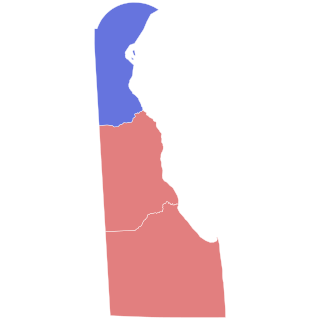2010 United States House of Representatives election in Delaware
From Wikipedia, the free encyclopedia
The 2010 United States House of Representatives election in Delaware was held on November 2, 2010, to determine who would represent the state of Delaware in the United States House of Representatives for the 112th United States Congress. Democratic nominee former Lieutenant Governor, John Carney defeated Republican nominee Glen Urquhart, giving Delaware an all Democratic congressional delegation for the first time since before the 1942 midterms.[1] This is the first open seat election since 1992 and only the second since 1976.
| |||||||||||||||||
| |||||||||||||||||
Carney: 50–60% 60–70% 70–80% 80–90% >90% Urquhart: 50–60% 60–70% | |||||||||||||||||
| |||||||||||||||||
Overview

The state of Delaware is completely contained in a single at-large district. The district has a Cook Partisan Voting Index of D+7.[2] Since 1993, the district had been represented by Republican Michael Castle.
Castle announced in 2009 he would run for the United States Senate seat[3] held by Ted Kaufman (D) who had been appointed to the seat when his predecessor, Joe Biden (D), resigned to become Vice President. Castle was defeated by Christine O'Donnell in the Delaware Republican Senate primary.
Democratic primary
Candidates
Results
Carney announced his candidacy on April 15, 2009, and was unopposed in the primary after Scott Spencer, a transportation consultant, dropped out.[4][5]
Republican primary
Candidates
- Glen Urquhart, businessman
- Michele Rollins, businesswoman and former Miss District of Columbia USA and former Miss World America 1963
- Rose Izzo, columnist
Results
| Party | Candidate | Votes | % | |
|---|---|---|---|---|
| Republican | Glen Urquhart | 27,343 | 48.64 | |
| Republican | Michele Rollins | 26,789 | 47.66 | |
| Republican | Rose Izzo | 2,082 | 3.70 | |
| Total votes | 56,214 | 100.00 | ||
Campaign
Summarize
Perspective
According to a September 2010 poll by Fairleigh Dickinson University's PublicMind, "likely voters in Delaware split 45%-40% on whether they prefer[ed] to have the U.S. Congress controlled by the Democratic Party or the Republican Party, suggesting that the First State's open congressional seat might be hotly contested," yet in the same poll, Carney led Urquhart by 51%-36%.[7] Peter Woolley, the poll director, remarked that "candidates matter, not just parties" and that in Delaware candidates matter "more than in most states."[7]
Polling
| Poll source | Date(s) administered | Glen Urquhart (R) |
John Carney (D) |
|---|---|---|---|
| Monmouth University[8] | October 25–27, 2010 | 44% | 51% |
| Fairleigh Dickinson[9] | October 20–26, 2010 | 36% | 53% |
| Monmouth University[10] | October 8–11, 2010 | 44% | 53% |
| Fairleigh Dickinson[11] | September 27 – October 3, 2010 | 36% | 51% |
| University of Delaware[12] | September 16–30, 2010 | 31% | 48% |
| Wilson Research Strategies[13] | September 27–28, 2010 | 41% | 45% |
| Grove Insight[14] | September 15–18, 2010 | 32% | 50% |
| Public Policy Polling[15] | September 11–12, 2010 | 37% | 48% |
| Public Policy Polling[16] | August 7–8, 2010 | 30% | 48% |
General election
Results
| Party | Candidate | Votes | % | |||
|---|---|---|---|---|---|---|
| Democratic | John Carney | 173,543 | 56.78 | |||
| Republican | Glen Urquhart | 125,442 | 41.04 | |||
| Independent Party | Earl R. Lofland | 3,704 | 1.21 | |||
| Libertarian | Brent A. Wangen | 1,986 | 0.65 | |||
| Blue Enigma | Jeffrey Brown | 961 | 0.31 | |||
| Total votes | 305,636 | 100.00 | ||||
| Democratic gain from Republican | ||||||
Counties that flipped from Republican to Democratic
- New Castle (largest city: Wilmington)
References
External links
Wikiwand - on
Seamless Wikipedia browsing. On steroids.




